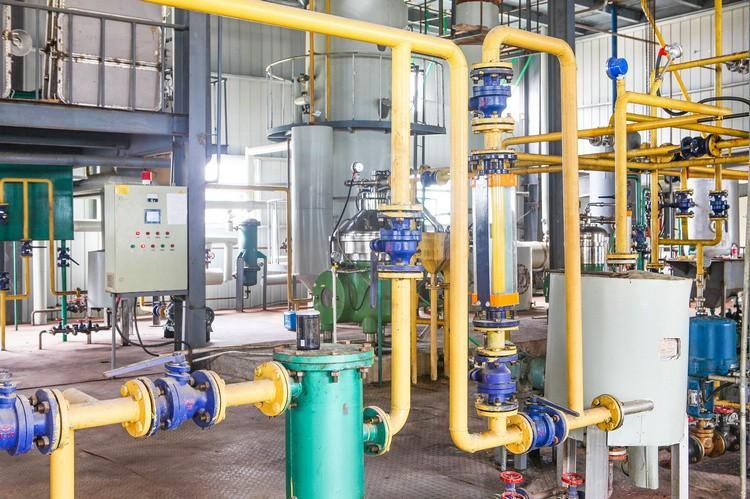China leading palm oil mill plant machine manufacturer and supplier
Email:info01@cnoilmachine.com
General process of refining engineering: crude oil → hydration → degumming → deacidification → dehydration → decolorization → deodorization → dewaxing → quality inspection → filling → refined oil
1. Hydration degumming: Hydration degumming utilizes the hydrophilicity of peptidyl impurities such as phospholipids to add an appropriate amount of water or dilute electrolyte solution to the crude oil under stirring, so that the peptidic impurities in the crude oil absorb water, swell, and condense. A degumming method that separates and removes. During the hydration and degumming process, the main substances that can be condensed and precipitated are phospholipids, in addition to proteins, mucus and trace metal ions that are combined with phospholipids.
2. Alkaline refining and deacidification: Various unrefined crude oils contain some amount of free fatty acids. The process of removing free fatty acids from oil is called deacidification. Deacidification methods include alkali refining, distillation, solvent extraction and esterification. Alkali refining and steam distillation (physical refining) are widely used in industrial production.
3. Oil decolorization: The adsorption and decolorization of oil is to use certain substances with strong selective adsorption of pigments (such as bleaching earth, activated clay, activated carbon, etc.) to adsorb pigments and other impurities in oil under appropriate conditions. Thereby achieving the purpose of decolorization. The grease treated with the adsorbent not only achieves the purpose of improving the oil color and removing gum, but also effectively removes some trace metal ions in the grease and some substances that can cause poisoning of the hydrogenation catalyst, thereby further refining the grease. (Hydrogenation, deodorization) provides good conditions.
4. Oil deodorization: Oil deodorization is a process that utilizes the difference in the volatilization of odorous substances in oil and triglyceride fatty acid esters to deodorize the odorous substances with the help of steam distillation under high temperature and high vacuum conditions. The principle of steam distillation (also called steam stripping) deodorization is that water vapor passes through grease containing odor components, and the vapor and liquid surfaces are in contact. The water vapor is saturated with volatile odor components, and the water vapor is saturated with the volatile odor components according to the ratio of their partial pressures. escape, thereby achieving the purpose of removing odor components.
The palm oil refinery process removes water, odouriferous matter, phosphatides, free fatty acids and other impurities including dirt and traces of metals from palm oil mill. After processed in palm oil refinery plant, the final oil product is a kind of premium edible oil of consistent quality which not only satisfies customer requirements and industry’s standards in respect of Iodine Value, FFA, flavor, color, melting point, peroxide value, impurities and moisture. any need please email to info01@cnoilmachine.com

If you are interested in our palm oil machine and palm oil mill plant. You can contact us through online consultation, filling out the form below, email, phone, etc. Our engineers will customize the most suitable plan and best price for you.